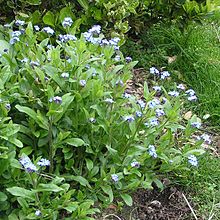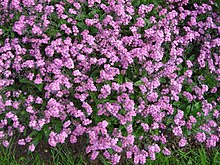Forest forget-me-nots
| Forest forget-me-nots | ||||||||||||
|---|---|---|---|---|---|---|---|---|---|---|---|---|

Forest forget-me-nots ( Myosotis sylvatica ) |
||||||||||||
| Systematics | ||||||||||||
|
||||||||||||
| Scientific name | ||||||||||||
| Myosotis sylvatica | ||||||||||||
| Honor ex Hoffm. |
The forest forget-me-not ( Myosotis sylvatica ) is a type of plant from the genus forget-me-not ( Myosotis ) within the predatory family (Boraginaceae). It is widespread in Eurasia .
description

Vegetative characteristics
The forest forget-me-not is a biennial to perennial herbaceous plant that reaches heights of 15 to 45 centimeters. It is usually richly branched, with a spread or erect stem . The leaves are arranged alternately, with the rosette leaves stalked and the broad-lanceolate stem leaves sitting. The leaves are hairy short.
Generative characteristics
The hermaphrodite flowers are radially symmetrical with a double flower envelope . The calyx with linear lobes is hairy loose and protruding; the longest hook hairs are 0.2 millimeters long. Several of the flowers are in an upright panicle. The crown is initially reddish purple, later sky blue. The corolla tube is narrowed by yellow pharynx scales. The flowering period extends from May to July.
The Klausenfrucht (fissure fruits) disintegrate into four Klausen , which are less than 1.7 millimeters long.
The number of chromosomes is 2n = 18.
ecology
The forest forget-me-not is a perennial semi-rosette plant and a forest plant . The edges of their leaves have a stabilizing effect on the plant when they relax. The vegetative reproduction takes place through short, above-ground runners .
From an ecological point of view, these are homogamous "plate-like flowers" with enclosed stigmas and anthers. The entrance to the flower is narrowed by five yellow scales, which serve as a barrier for smaller visitors unable to pollinate; the gullet scales act at the same time as a sap ring and, above all, as dummy dust bags. The nectar is for bees , butterflies and long-nosed flies , e.g. B. also available for dance flies . The stigma and the anthers are at the same height, so self-pollination is possible even before blossoming . With a diameter of just 0.005 millimeters, the pollen grains are among the smallest in the local flora.
The Klausen are subject to swimming and they are spread out as wind spreaders. Fruit ripening is from June to August.
Occurrence
The forest forget-me-not is originally found in Europe, the Caucasus, Western Asia, India, Pakistan, Bhutan and Nepal. In South Africa, Madeira, Australia, New Zealand, North America, Argentina and Chile it is a neophyte. In Germany, this plant species is particularly common in the southern part and rises up to 1860 meters. In Austria, the forest forget-me-not is common in all federal states, from the submontane to the montane altitude level .
The Myosotis sylvatica preferred location fresh fat meadows , hems , Forest blows Hochstaudenfluren and cattle stockyards. The forest forget-me-not thrives best on fresh to moist, nutrient-rich and base-rich, loose, humus-rich soils . It is a type of character of the Schlagfluren (Atropetalia belladonnae).
Ornamental forms of the forest forget-me-nots are used in gardens and are overgrown in places.
Systematics
Myosotis sylvatica was first published in 1791 by Jakob Friedrich Ehrhart in Georg Franz Hoffmann . Synonyms for Myosotis sylvatica Hoffm. are: Myosotis popovii Dobrocz. , Myosotis pyrenaica Pourr. , Myosotis alpestris subsp. pyrenaica (Pourr.) Litard. , Myosotis myriantha Domin .
Of Myosotis sylvatica , there are about four subspecies:
- Myosotis sylvatica Hoffm. subsp. sylvatica (Syn .: Myosotis sylvatica subsp. Gayéri Soó )
- Myosotis sylvatica subsp. cyanea (Hayek) Vestergr. : It occurs in Italy , Bulgaria , the Balkan Peninsula and Turkey .
- Myosotis sylvatica subsp. elongata (Strobl) Gray : It occurs in Italy including Sicily .
- Myosotis sylvatica subsp. rivularis Vestergr. : It occurs in Armenia and Turkey .
- Myosotis sylvatica subsp. subarvensis gray : It occurs in Italy including Sicily and Croatia .
literature
- Gunter Steinbach (Ed.), Bruno P. Kremer u. a .: wildflowers. Recognize & determine. Mosaik, Munich 2001, ISBN 3-576-11456-4 .
- Manfred A. Fischer, Wolfgang Adler, Karl Oswald: Excursion flora for Austria, Liechtenstein and South Tyrol . 2nd, improved and enlarged edition. State of Upper Austria, Biology Center of the Upper Austrian State Museums, Linz 2005, ISBN 3-85474-140-5 .
- Ruprecht Düll , Herfried Kutzelnigg : Pocket dictionary of plants in Germany and neighboring countries. The most common Central European species in portrait . 7th, corrected and enlarged edition. Quelle & Meyer, Wiebelsheim 2011, ISBN 978-3-494-01424-1 .
Individual evidence
- ↑ a b c Erich Oberdorfer : Plant-sociological excursion flora for Germany and neighboring areas . With the collaboration of Angelika Schwabe and Theo Müller. 8th, heavily revised and expanded edition. Eugen Ulmer, Stuttgart (Hohenheim) 2001, ISBN 3-8001-3131-5 , pp. 781 .
- ^ A b Myosotis in the Germplasm Resources Information Network (GRIN), USDA , ARS , National Genetic Resources Program. National Germplasm Resources Laboratory, Beltsville, Maryland. Retrieved July 19, 2020.
- ↑ Deutsche Flora or Botanisches Taschenbuch for the year 1791 , p. 61
- ↑ a b c d e f Benito Valdés, 2011: Boraginaceae. : Datasheet at Euro + Med Plantbase - the information resource for Euro-Mediterranean plant diversity . Last accessed on February 6, 2016
Web links
- Profile and distribution map for Bavaria . In: Botanical Information Hub of Bavaria .
- Myosotis sylvatica Ehrh. ex Hoffm., forest forget-me-not. In: FloraWeb.de.
- Myosotis sylvatica agg., Species group forest forget-me-nots. In: FloraWeb.de.
- Myosotis sylvatica subsp. sylvatica Ehrh. ex Hoffm., forest forget-me-nots (subspecies). In: FloraWeb.de.
- Forest forget-me-nots . In: BiolFlor, the database of biological-ecological characteristics of the flora of Germany.
- Myosotis sylvatica Hoffm. In: Info Flora , the national data and information center for Swiss flora . Retrieved February 6, 2016.
- Distribution in the northern hemisphere according to Eric Hultén .
- Thomas Meyer: Forget-me-not data sheet with identification key and photos at Flora-de: Flora von Deutschland (old name of the website: Flowers in Swabia ).





